Welcome to my key spec and feature comparison between the Sony A9II and the Sony A9III.
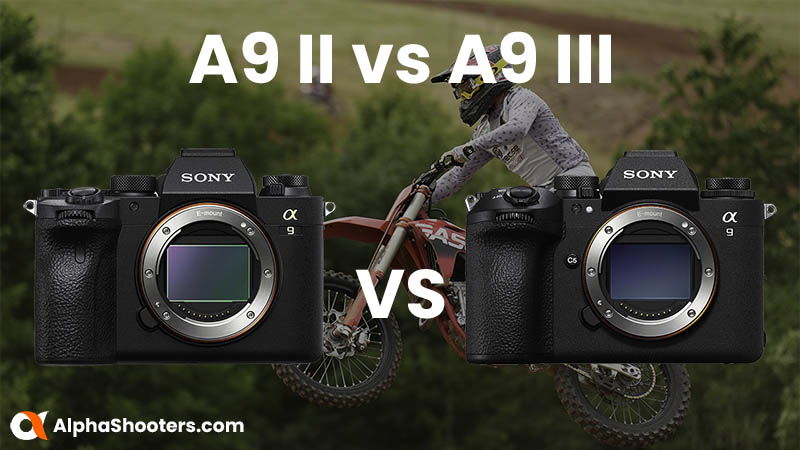
The Sony A9II was released in October 2019 but offered only a handful of improvements over the A9 Mark I. As an owner of the Mark I at the time the A9II didn’t offer me any significant reasons to upgrade.
With the introduction of the A9III Sony has introduced some very significant game changing features but there’s also a substantial price increase of around $1,500.00 US dollars.
In this article I’ll be comparing these two cameras side-by-side and hopefully helping you to decide which one you’d prefer to be shooting with.
Table of Contents[Hide][Show]
- Summary
Key Feature Differences+−
- Sensor: Rolling Shutter vs Global Shutter
- ISO Sensitivity & Dynamic Range
- Image Processor
- Continuous Shooting Speed
- Pre-Capture
- Shutter and Flash Sync Speed
- Autofocus
- Image Stabilization
- Composite RAW Shooting
- Video
- Viewfinder, LCD Monitor & Menu
- Camera Body & Controls
- Memory Cards
- Battery Life
- Additional Features
- Price
- What’s in the Box
- Conclusion
- Reviews
Summary
With almost four years between these camera models the A9III was always going to pack a punch when comparing the two side-by-side.
The biggest improvements are the global shutter, faster 120 fps continuous shooting, additional subject recognition and tracking, pre-capture, improved 8 stop stabilization, 4k 120p video and a new more ergonomic designed body.
Whilst the A9II does lack the latest and greatest features, it’s certainly no slouch. If you are a sports or wildlife photographer this camera still packs a serious punch. 20 fps is more than enough for most photographers and the autofocus performance will certainly not leave you disappointed.
Key Feature Differences
There are some very big differences between these two A9 series mirrorless cameras, here we dive into a little more detail.
Sensor: Rolling Shutter vs Global Shutter
Both cameras feature a 35mm full-frame stacked Exmor RS™ CMOS image sensor with 24.2 megapixels for the A9II and 24.6 megapixels for the A9III.
However, the method used to capture the images is very different. Whereas the A9II features a rolling shutter the A9III features a global shutter which is the first to find its way into a mirrorless camera.
A global shutter can expose and read all of the pixels simultaneously, whereas a rolling shutter records images sequentially one row at a time from the top row of pixels to the bottom.
The global shutter allows the A9III to shoot up to an incredibly fast shutter speed of 1/80000 second (1/16000 second during continuous shooting).
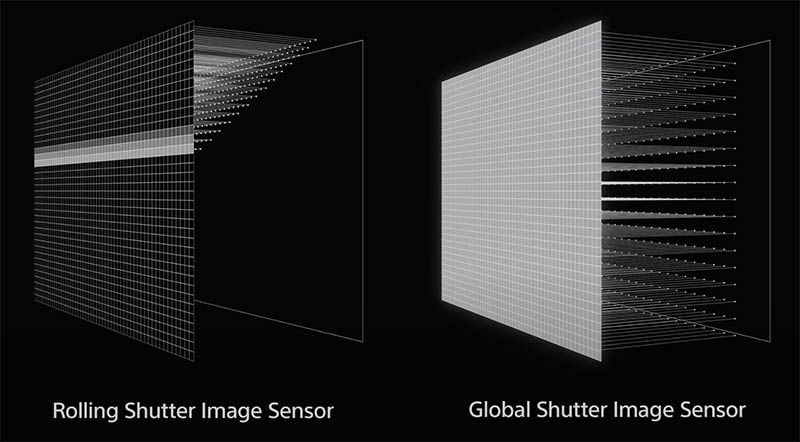
For a more animated explanation this video from B&H Photo is worth a watch:
The A9II features both a mechanical and electronic rolling shutter, but if you want to achieve the maximum of 20 frames per second you’ll need to use the electronic shutter. However, using the electronic shutter comes with some limitations.
The rolling shutter effect is one of the largest concerns, this can be seen when panning the camera very quickly and is generally much worse for video than still images.
However, because the A9II uses a very fast stacked sensor distortion from the rolling shutter whilst shooting still images with the e-shutter is rarely an issue.
What tends to be more of an issue is banding from artificial lights such as those found in sports stadiums and also limited flash sync possibilities (you can’t actually use flash with the A9II together with the electronic shutter, only the mechanical shutter and this is limited to a sync speed of 1/250s).
Switching from the electronic to the mechanical shutter can help to minimize the risk of rolling shutter distortion and also banding, but now the A9II limits you to only 10 frames per second.
The A9III’s global shutter solves the limitations of the rolling shutter and also eliminates the need for including a mechanical shutter, in doing so this also eliminates a potential source of failure and some excess weight.
ISO Sensitivity & Dynamic Range
The A9II has a wider ISO range than the A9III.
Surprisingly the A9III has a native base ISO of 250 compared to ISO 100 for the A9II.
However, they both share the same maximum native ISO when comparing electronic shutters of ISO 25,600.
The A9III appears to have an advantage when we look at the expanded ISO figures from the electronic shutters, with ISO 51,200 vs 25,600 for the A9II.
We will have to wait a little while longer for some real-world images to compare image quality and also learn how many stops of dynamic range the A9III has because so far Sony has not shared this information. The A9II has a maximum 14-stops of dynamic range at base ISO 100.
| Sony A9II | Sony A9III | |
|---|---|---|
| Native ISO (Stills): | ISO 100-51,200 (Mechanical Shutter) ISO 100-25,600 (Electronic Shutter) | ISO 250-25,600 |
| Expanded ISO (Stills): | ISO 50-204,800 (Mechanical Shutter) ISO 50-25,600 (Electronic Shutter) | ISO 125-51,200 |
| Native ISO (Movies): | ISO 100-51,200 | ISO 250-25,600 |
| Expanded ISO (Movies): | ISO 100-102,400 |
Image Processor
The Sony A9II features the now older BIONZ X™ image processing engine, whereas the A9III receives the latest BIONZ XR™ processor.

The BIONZ XR™ delivers up to eight times more processing power than previous BIONZ X™, helping to minimize processing latency while boosting image processing power.
The enormous volume of data generated by the Exmor RS™ image sensor can be processed in real time even while shooting continuous bursts at up to 120 fps.
Continuous Shooting Speed
The A9II can shoot at up to 20 fps with full AF/AE tracking and no viewfinder blackout, although to reach the maximum speed you will need to shoot in Compressed RAW which reduces the files to 12-bit vs 14-bit for Uncompressed RAW.
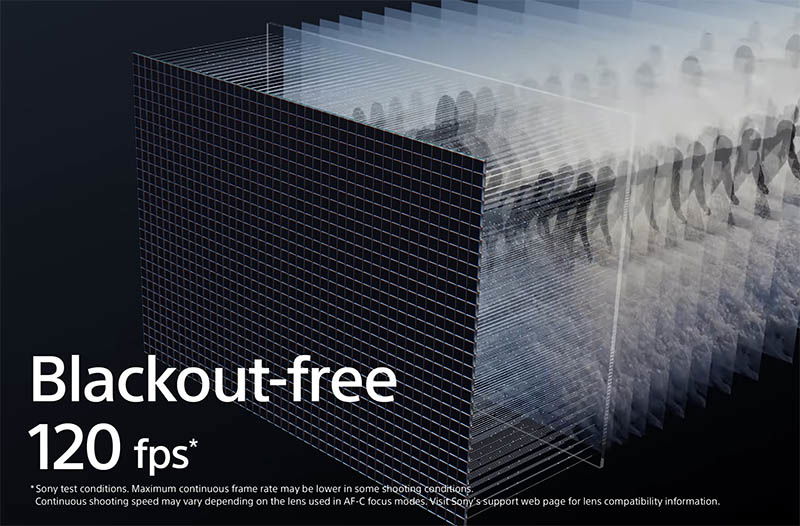
The A9III can shoot up to 120 fps with full AF/AE tracking, zero blackout and also capture high quality 14-bit RAW images in all still shooting modes.
However, the maximum speed of 120 fps can only be maintained for 192 frames (1.6 seconds) when using a fast CFexpress Type-A card. The buffer will increase for slower shutter speeds but Sony has not yet provided any figures so far.
It’s also important to note that not every E-mount lens will be compatible with the fastest speed of 120 fps. Sony does provide a list of compatible lenses but these will also require a firmware update (coming in December 2023).
Continuous Shooting Speed Boost
A new feature introduced with the A9III is called Continuous Shooting Speed Boost. This can be enabled by pressing a custom button such as the new C5 button next to the lens mount.
When enabled it temporarily boosts the shooting speed while shooting bursts, enabling the user to raise the frame rate to 120 fps as a key moment approaches.

However, Sony does say that if [Continuous Shooting Speed Boost] is used and the camera is switched from low speed to high speed (60 shots per second or more) or from high speed to low speed (30 shots per second or less), there will be times when continuous shooting will be interrupted.
Pre-Capture
Pre-capture is another new feature introduced for the first time in the A9III making it possible to capture moments that occurred before the shutter was released.
Up to 120 images per second are temporarily stored while the shutter button is half-pressed, and can be captured up to one second before the shutter is fully pressed.
This makes it easier to capture split-second moments, such as images of birds taking flight, even if you aren’t quite quick enough to fully press the shutter button.
This is definitely a feature that I have been waiting for after trying it with the Canon R7. It’s just a shame we probably won’t see it introduced to any of Sony’s existing cameras via firmware update but I’d love to be wrong on this!
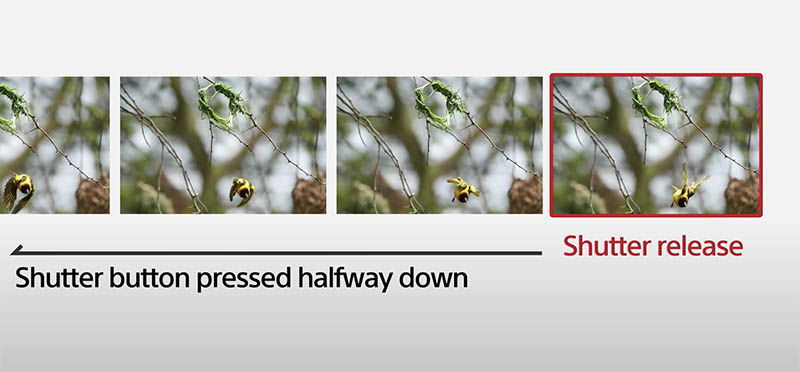
Shutter and Flash Sync Speed
Sony’s mechanical shutters are typically limited to 1/8000s with the A7 and A9 series. However, switching to the electronic shutter on the A9II takes the maximum shutter speed up to 1/32,000s.
The A9III makes another big leap here and takes the shutter speed to a very impressive 1/80,000s for stills, although this is limited to 1/16,000s when shooting continuously.
What’s even more impressive with the A9III is that the camera can also perform full flash sync at up to 1/80,000s when using a compatible flash unit from Sony (such as the HVL-F60RM2 or HVL-F46RM).

For these flashes to work correctly a software release is planned to coincide with the A9III release date in early 2024. Note: If the shutter speed is set faster than 1/10000, brightness and color may change. Further, depending on the shutter speed setting, the light level may be insufficient, and may not reach the set manual flash output. For more information, please see the dedicated support page: https://www.sony.net/dics/ilce9m3fl/
The maximum shutter speed of the A9III is limited to 1/16000s when an aperture of F1.8 or larger is used. Also 1/80000s is not available when shooting movies or when using the Var. Shutter function.
The A9II has a maximum flash sync speed of 1/250s and flash sync is only possible whilst using the mechanical shutter.
Autofocus
The autofocus system in the A9II is certainly no slouch. It features 693 phase detection points that cover 93% of the image sensor and can perform 60 AF/AE calculations per second. It also supports real-time tracking and Eye AF for humans and animals that works very well.
The A9III features a new AI processing unit with 759 phase detection points (96% coverage) and can perform 120 AF/AE calculations per second, double what the A9II is capable of.

It also features enhanced Human, Animal, Bird, Insect, Car/Train and Airplane recognition. In the Car/Train category, it is now capable of recognizing helmets, such as those worn by the drivers of F1 cars.
Animal recognition can recognize the eyes of some grazing and small animals, in addition to the eyes, heads, and bodies of dogs, cats, and similarly featured animals.
Bird recognition has also been improved, more easily pinpointing the eyes of a variety of bird types as well as recognizing bird bodies. Plus, a new Animal/Bird setting eliminates the need to switch between two settings to shoot animals or birds.

The A9III’s Eye AF also works for animals and birds in video mode, where it’s restricted to humans only on the A9II.
Sony has also added two new sizes for the Spot Focus Area on the A9III: Extra Small and Extra Large. XS can be useful when shooting wildlife and trying to avoid focusing on foreground branches, for example.
Finally, the A9III has an AF advantage in low-light conditions, with a two-stop improvement over the A9II.
- A9II: -3EV (ISO 100 equivalent with F2.0 lens attached)
- A9III: -5EV (ISO 100 equivalent with F2.0 lens attached)
Image Stabilization
The Sony A9II features five-axis image stabilization that offers 5 stops of compensation.
The A9III comes with the new generation of sensor shift mechanism that was first introduced in the Sony A7RV, this offers a maximum of 8 stops of compensation.
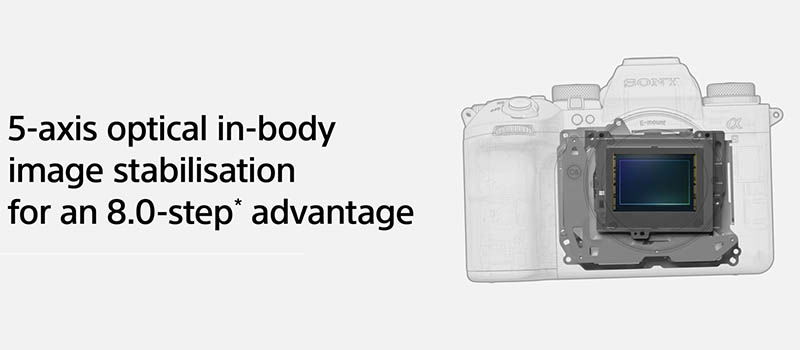
The A9III also features Dynamic Active Mode Stabilization. This works in conjunction with the camera’s 5-axis optical in-body image stabilization system to improve stabilization by more than 30% over the existing Active Mode which uses data from the built-in gyro sensor to enhance stability during hand-held video recording.
Composite RAW Shooting
The A9III is the first camera to feature Composite RAW Shooting, so you won’t find this feature on the A9 Mark II.
Composite RAW Shooting captures multiple images (4, 8, 16, or 32, selectable) which can then be merged using Sony’s Imaging Edge Desktop software to create full-resolution images with very low noise.
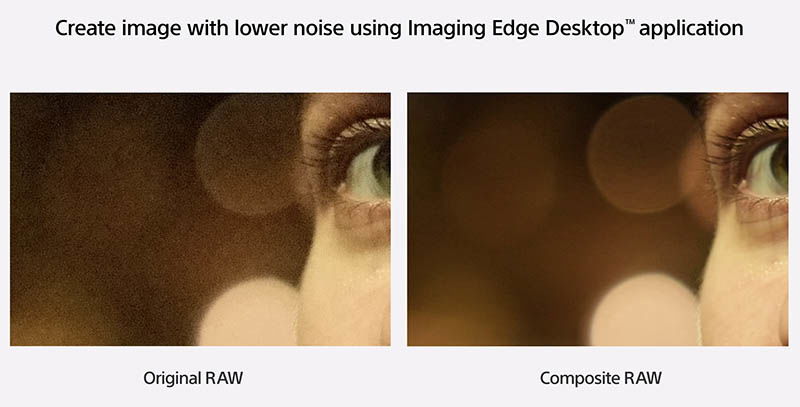
Video
The A9II can record 4K 30p with full pixel readout and oversampling (using a 6K area on the sensor).
Unfortunately Sony has always limited the video capabilities of the A9 Series by removing the Picture Profiles such as S-Log and HLG. The A9II does include Creative Styles but these are designed for stills not video.
However, with the A9III Sony has provided some very welcome features for video shooters.
The A9III can record in 10-bit 4:2:2 internally or output 16-bit RAW via the HDMI port. It can record with All-Intra compression up to 600Mbps, except in 4K 120p.

Picture profiles are now included with options for S-Log3 and S-Cinetone.
For the first time in the Alpha Series, the A9III offers 4K (3840 x 2160) 120p movie recording without cropping and at 60p with full pixel readout and 6K oversampling.
The A9III also includes additional video features such as Focus Breathing Compensation and Auto Framing.
Focus breathing compensation effectively reduces focus breathing when shooting movies providing a supported lens is used.
The Auto Framing feature automatically crops the frame to keep the subject in a prominent position when shooting movies, even when the camera is mounted on a tripod.
Viewfinder, LCD Monitor & Menu
The electronic viewfinder on the A9II is pretty reasonable with 3,686,400 dots, 0.78x magnification and a higher frame-rate option of 120 fps.
The A9III inherits the newer EVF from the Sony A1 which provides 9,437,184 dots, 0.90x magnification and a higher frame-rate option of 240 fps. The 240 fps setting provides an extremely smooth viewfinder image with minimum motion blur when shooting moving subjects.
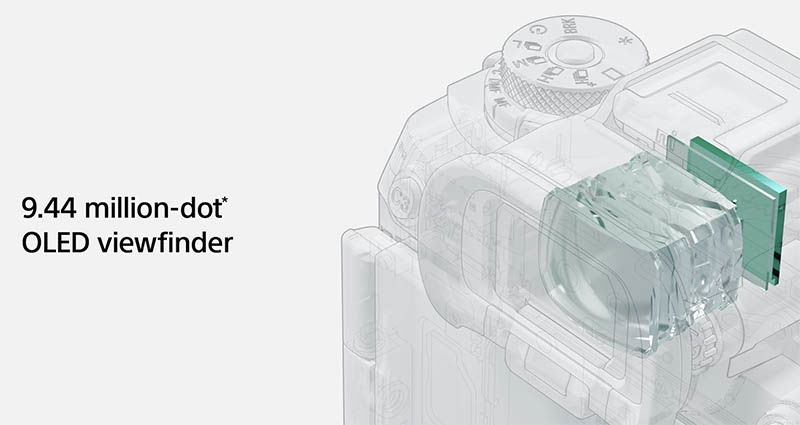
There’s also a difference when we come to look at the LCD displays. The A9II features a 3.0 inch 1.44 million dot LCD with tilt only (up by approx. 107 degrees, down by approx. 41 degrees).
The A9III really shines here because it features the same 4-axis LCD found in the Sony A7RV. Since I own the A7RV myself I can confirm that this is an excellent display.
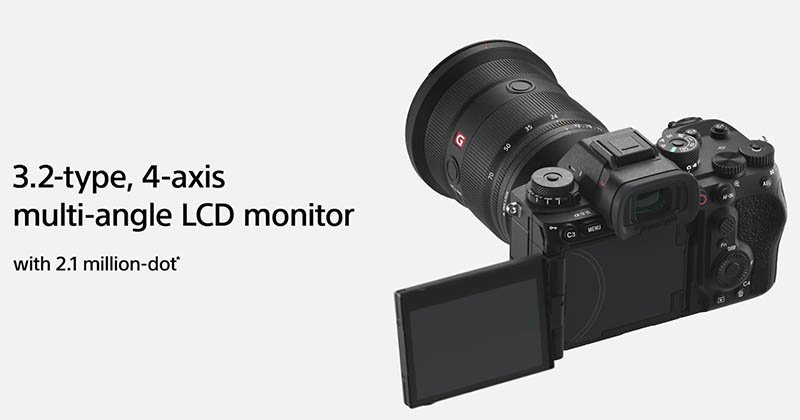
The A9III LCD combines the utility of a conventional tilting monitor with side-opening vari-angle flexibility, allowing for unrestricted angle adjustment whether shooting vertically or horizontally. The mechanism enables the monitor to be pulled away from the rear of the body and tilted upward by up to 98°, downward by up to 40°, and swung sideways by up to 180°.
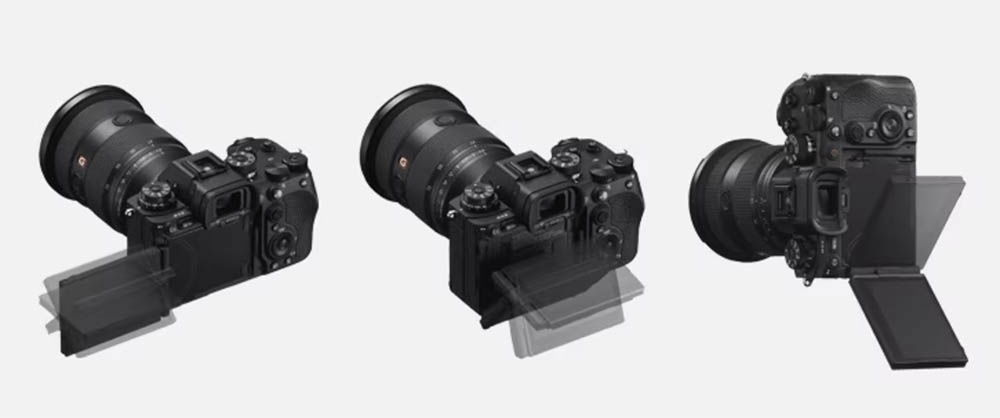
The touch sensitive, 3.2 inch LCD monitor is optimized for outdoor shooting, providing a 2.1 million dot resolution and a wide color gamut.
Although both camera’s LCD are touch sensitive, the A9II only features the most basic of touch controls such as touch to focus or track, it also features the older and less intuitive menu design.
The A9III improves on this significantly by adding a refreshed menu design, additional touch gesture support such as touch to swipe and also enabling touch navigation and selection of menu items.
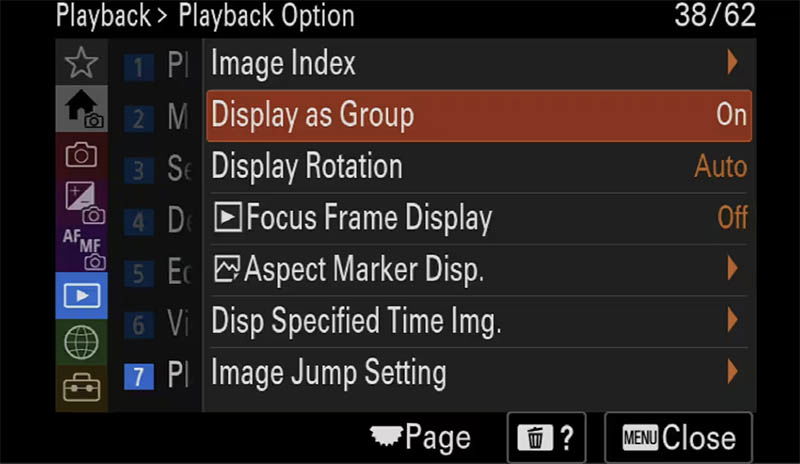
An improved group display option on the A9III also helps to improve your workflow efficiency. Images taken at up to 120 fps in continuous bursts can be defined as “groups,” making it easier to locate a specific image within a large group of images.
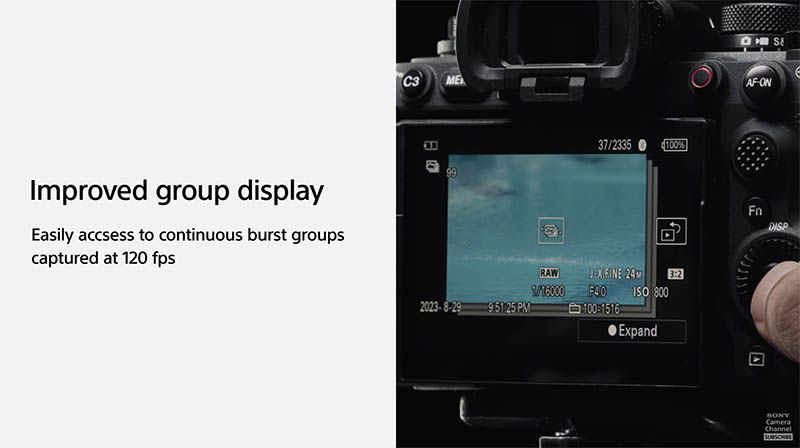
Camera Body & Controls
The A9III features a redesigned grip that is supposed to improve holding the camera and reduce stress, even when shooting with heavy telephoto lenses. The grip is a little larger and the shutter button now sits at more of an inclined angle.

An additional C5 custom button can now be found on the front of the camera for faster, easier operation while holding the grip. The drive mode dial can also be deactivated if you’d prefer to use a custom button or function menu instead.
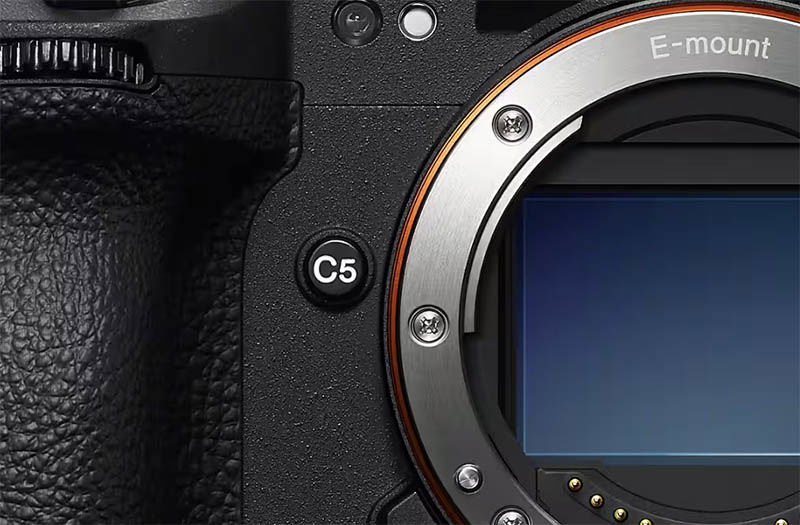
The exposure compensation dial on the A9III is now blank and also customizable in-camera. Some buttons are also a little larger than what you’ll find on the A9II and you’ll now also find a dedicated stills/movies/S&Q dial under the mode dial, allowing individual settings to be set and recalled for stills and movies.
Whereas the A9II features a Type-D micro HDMI port the A9III gets a full-size Type-A HDMI port. Both cameras include a LAN terminal and a USB-C port (5Gbps).
The A9III receives improved 5 GHz Wi-Fi (IEEE 802.11ac) with 2×2 MIMO support that allows high-speed data transfer, enabling the A9III to transfer data up to twice as fast as the A9II.
The A9III also features a shading curtain that protects the image sensor from dust and particles while changing lenses. When set to ON, it automatically closes when the camera’s power is turned off.
The A9III gets a new vertical grip (VG-C5) to match the updated body design. It also works a little differently to the Sony VG-C4EM grip supported by the A9II. Whereas the VG-C4EM treats both batteries independently and discharges one after the other, the VG-C5 grip treats both batteries as one which according to Sony improves the battery efficiency.
The dimensions and weights of each camera are as follows:
- A9II: 128.9mm x 96.4mm x 77.5mm (678 g / 1 lb 8.0 oz with battery and memory card)
- A9III: 136.1 x 96.9 x 82.9 mm (702 g / 1 lb 8.8 oz with battery and memory card)
Sony A9II

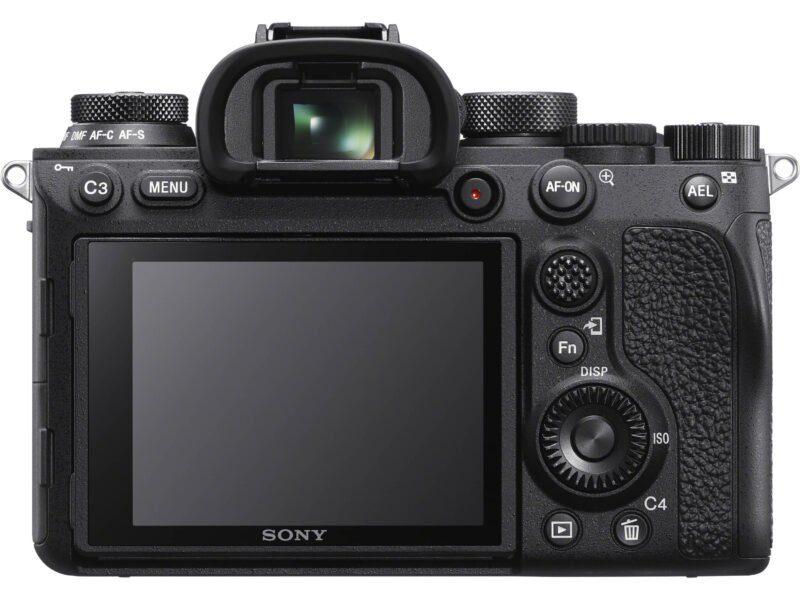
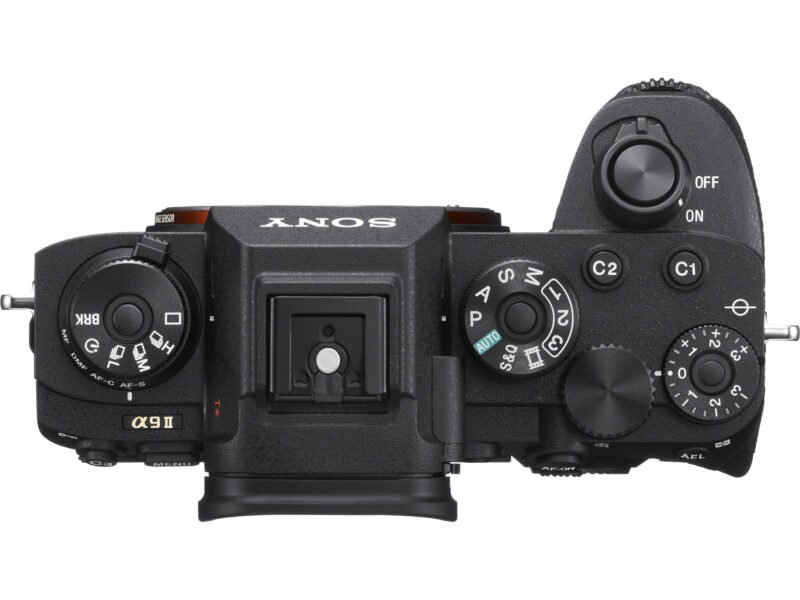
Sony A9III
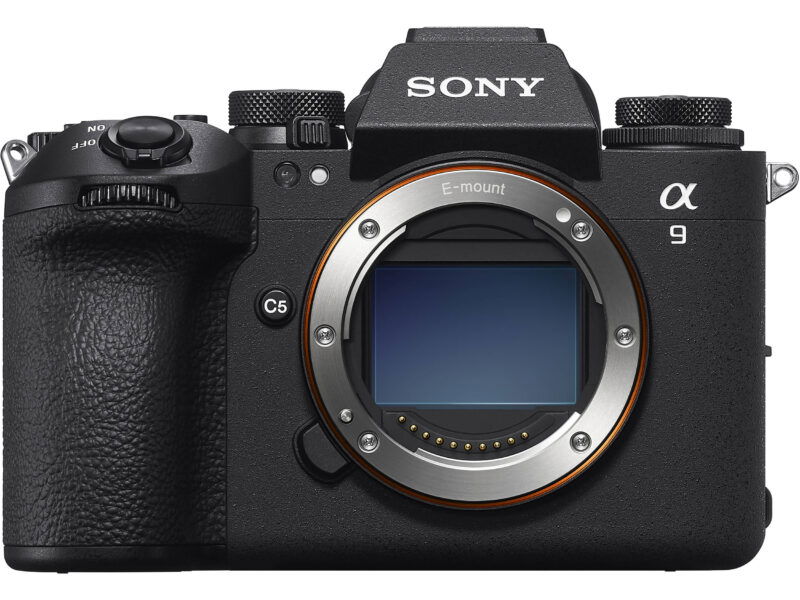
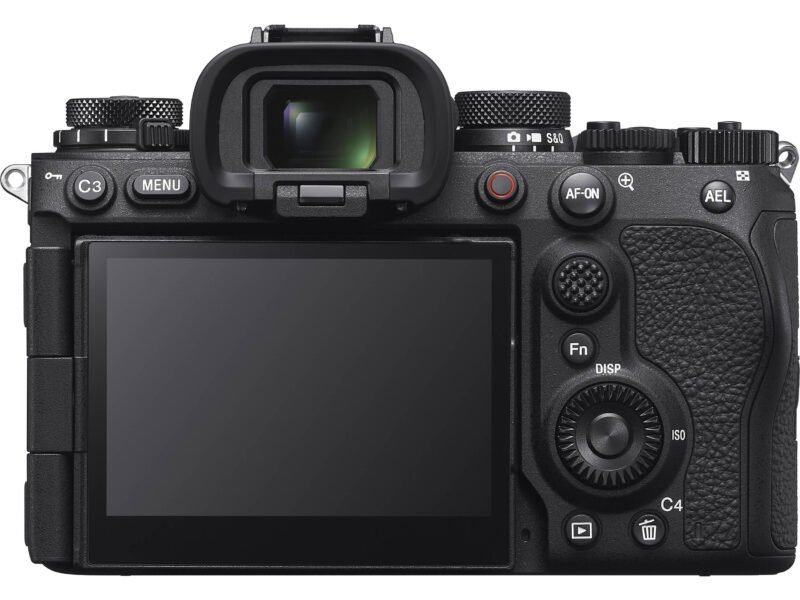
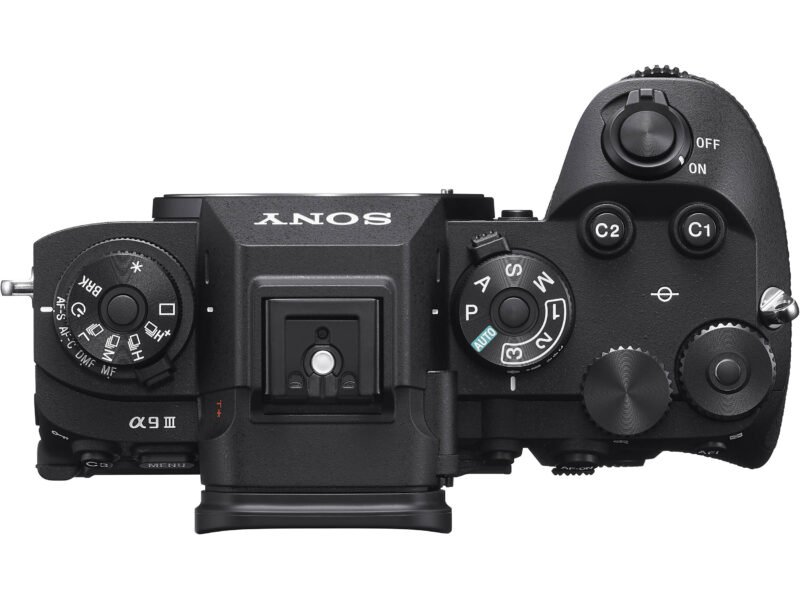
Memory Cards
The A9II has dual memory card slots but these only support UHS-I/UHS-II (SD/SDHC/SDXC) memory cards.
The A9III also features dual memory card slots but these support the much faster and much more expensive CFexpress Type-A cards, fortunately the slots also support UHS-I/UHS-II cards.
Although if you want to take advantage of the fastest frame rates you’ll certainly want to be using CFexpress Type-A cards. My Sony A9III Memory Card Guide provides further advice on the best memory cards to use with the A9III.

Battery Life
Both cameras utilize Sony’s NP-FZ100 battery, although the A9III’s global shutter is more power hungry than the rolling shutter of the A9II:
- A9II: Approx. 500 shots (EVF) or 690 shots (LCD) CIPA standard
- A9III: Approx. 400 shots (EVF) or 530 shots (LCD) CIPA standard
The A9III supports power delivery via its USB-C port which the A9II doesn’t.
Additional Features
There are a number of additional features introduced with the A9III that you won’t find on the A9II, these are:
- USB webcam / streaming
- Firmware updates via memory card
- Preset Focus/Zoom
- C2PA authentication metadata (coming with a firmware update in Spring 2024)
- Multiple IPTC presets
Price
The global shutter in the A9III appears to come with a substantial price increase of $1,500.00 over the A9II’s current RRP price.
| Sony A9II | Sony A9III | |
|---|---|---|
| MRSP Body-Only | $4,498.00 / £3,999.00 | $5,998.00 / £6,099.00 |
| Check Price / Deals | B&H Photo | Amazon | B&H Photo | Amazon |
What’s in the Box
The box contents are very similar except the A9III does not include a USB Type-C cable.
| Sony A9II | Sony A9III |
|---|---|
| Rechargeable Battery NP-FZ100 Battery Charger BC-QZ1 Power cord Cable Protector Shoulder strap Body cap Accessory shoe cap Eyepiece cup USB Type-C(TM) cable | Rechargeable Battery NP-FZ100 Battery Charger BC-QZ1 Power cord Cable Protector Shoulder strap Body cap Accessory shoe cap Eyepiece cup |
Conclusion
With almost four years between these camera models the A9III was always going to pack a punch when comparing the two side-by-side.
The biggest improvements are the global shutter, faster 120 fps continuous shooting, additional subject recognition and tracking, pre-capture, improved 8 stop stabilization, 4k 120p video and a new more ergonomic designed body.
Whilst the A9II does lack the latest and greatest features, it’s certainly no slouch. If you are a sports or wildlife photographer this camera still packs a serious punch. 20 fps is more than enough for most photographers and the autofocus performance will certainly not leave you disappointed.
With the A9III Sony has once again shown us that they have the capabilities to bring the latest imaging technology to the mirrorless market before the competition. How long will we have to wait until Canon or Nikon introduce a global shutter?
Not every photographer is going to need the blistering speeds and benefits that the global shutter of the A9III provides, but if you are a professional sports photographer shooting at the 2024 Olympic Games then it might be very appealing.
Reviews
There are very few reviews available right now for the A9III other than some first impressions from the launch event in New York. I’d recommend watching this one from Chris and Jordan at PetaPixel.
For the A9II I’d recommend this review from Dustin Abbott:
Complete Feature & Spec Comparison
To make sure nothing is missed here’s a complete comparison of the features and specifications of each camera.
Features
| Feature | Sony A9II | Sony A9III |
|---|---|---|
| Announced | October 3rd, 2019 | November 7th, 2023 |
| Camera Type | Mirrorless | Mirrorless |
| Sensor Size | 35mm full frame (35.6×23.8mm) | 35mm full frame (35.6 x 23.8 mm) |
| Sensor Type | Stacked and Back-illuminated Exmor RS™ CMOS image sensor | Stacked Exmor RS™ CMOS image sensor with global shutter |
| Resolution | 24.2 MP | 24.6 MP |
| Sensor Pixel Size | 5.93µm | |
| Pixel Dimensions | 6000 x 4000 | 6000 x 4000 |
| Image Processor | BIONZ X™ | BIONZ XR™ |
| Low Pass Filter | Yes | Yes |
| IBIS (In-Body Image Stabilization) | Yes (5.5 Steps) | Yes (8 Steps) |
| ISO (Mechanical Shutter) | ISO 100-51200 | – |
| ISO (Mechanical Shutter) Expended | ISO 50 to ISO 204800 | – |
| ISO (Electronic Shutter) | ISO 100-25600 | ISO 250 – 25600 |
| ISO (Electronic Shutter) Expended | ISO 50-25600 | ISO 125 – 51200 |
| High-Resolution Sensor Shift (Pixel Shift) | No | No |
| Composite RAW NR Shooting | No | Yes |
| Focus Bracketing | No | ? |
| Full Time DMF | No | Yes |
| Pre Capture | No | Yes |
| Continuous Shooting Speed Boost | No | Yes |
| XL and XS Focus Area Spot Sizes | No | Yes |
| Fastest Shutter Speed (Mechanical Shutter) | 1/8000s | – |
| Fastest Shutter Speed (Electronic Shutter) | 1/32000s | 1/80,000s but limited to 1/16,000s when shooting continuously. |
| Longest Shutter Speed | 30 seconds + Bulb | 30 seconds + Bulb |
| Continuous Shooting (Mechanical Shutter) | 10 FPS | – |
| Continuous Shooting (Electronic Shutter) | 20 FPS | 120 FPS |
| Notes for High FPS Shooting | ||
| Buffer Size (RAW Uncompressed) | 131 | ? |
| Buffer Size (RAW Compressed) | 239 | ? |
| Buffer Size (RAW Lossless Compressed) | – | ? |
| Buffer Size (JPEG Extra Fine L) | 361 | ? |
| Buffer Size (JPEG Fine L) | 361 | ? |
| Buffer Size (HEIF) | – | ? |
| Autofocus System | Fast Hybrid AF (phase-detection AF / contrast-detection AF) | Fast Hybrid AF (phase-detection AF / contrast-detection AF) |
| AF Subject Detection | Humans (Eye AF) | Humans, animals, birds, insects, cars/trains, and airplanes |
| Autofocus Points | 35mm full frame: 693 points (phase-detection AF), APS-C mode with FF lens: 299 points (phase-detection AF), with APS-C lens: 221 points (phase-detection AF) / 425 points (contrast-detection AF) | Still images: Max. 759 points (phase-detection AF), Movies: Max. 627 points (phase-detection AF) |
| Maximum Low-Light AF Sensitivity (Standardized to f/2, ISO 100) | EV-3 | EV-5 |
| Standard Flash Sync Speed | 1/250 s | 1/80000 s (with compatible Sony flash). |
| Curtain to Protect Sensor at Shutdown (Shutter Power Off) | No | Yes |
| Interval Shooting | Yes | Yes (with built in time-lapse) |
| Soft Skin Effect (stills / movies) | No | Yes |
| Creative Look | No | Yes (10 looks with 8 adjustments for each look: contrast, highlights, shadows, fade, saturation, sharpness, sharpness range, and clarity) |
| Creative Styles | Yes 13 Styles and contrast, saturation and sharpness can be adjusted. | No. Replaced by Creative Look. |
| My Image Style | No | No |
| Background Defocus | No | No |
| Face Memory | – | – |
Video Specific Features
| Feature | Sony A9II | Sony A9III |
|---|---|---|
| Maximum Video Bit Depth (Internal) | 8-bit 4:2:0 | 10-bit 4:2:2 All-I |
| External Raw Video | No | 16-bit RAW (HDMI) |
| 8K Maximum Frame Rate | – | – |
| 4K Maximum Frame Rate | 24/30p | 120p (no crop) 60p (oversampled) |
| 1080P Maximum Frame Rate | 120p | 120p |
| Additional Video Crop Factor | 4K/30p with a 1.2x crop | |
| Recording Formats | XAVC S, MP4, H.264 | XAVC S: MPEG-4 AVC/H.264, XAVC HS: MPEG-H HEVC/H.265 |
| Video Recording Limit | No | No |
| S-Cinetone | No | Yes |
| Picture Profiles (stills/movies) | No | Yes |
| Active Stabilization | No | Yes |
| Focus Breathing Compensation | No | Yes |
| Import User LUT Files | No | ? |
| AI Auto Framing | No | Yes |
| Focus Map | No | Yes |
| AF Assist | No | Yes |
| Time Code (TC) | Yes | Yes |
| In-Camera Time-Lapse Creation | No | Yes |
| Framing Stabilizer | No | – |
| Product Showcase Set | No | – |
| Cinematic Vlog Setting | No | – |
| Multiple Face Recognition in Intelligent Auto Mode | No | – |
Physical & Other Features
| Feature | Sony A9II | Sony A9III |
|---|---|---|
| Card Slots | 2 | 2 |
| Slot 1 Type | SD (UHS-II / I) | CFexpress Type-A + SD (UHS-II / I) |
| Rear LCD Size (Diagonal) | 7.5 cm (3.0 type) | 8.0 cm (3.2-type) type TFT |
| Rear LCD Resolution | 1 440 000 dots | 2 095 104 dots |
| Articulating LCD | Up by approx. 107 degrees, Down by approx. 41 degrees | Opening Angles (approx.): Up 98 °, down 40 °, side 180 °, rotation 270 ° |
| Touchscreen | Yes (basic) | Yes (advanced with swipe) |
| Viewfinder | EVF | EVF |
| Viewfinder Magnification | Approx. 0.78 x | Approx. 0.90x |
| Viewfinder Resolution | 3 686 400 dots | 9 437 184 dots |
| Viewfinder Frame Rate | Standard (60 fps), High (120 fps) | Standard (60 fps), High (120 fps), or Higher (240 fps) |
| Voice Memo | Yes | Yes |
| Headphone Jack | Yes (3.5 mm Stereo minijack) | Yes (3.5 mm Stereo minijack) |
| Microphone Jack | Yes (3.5 mm Stereo minijack) | Yes (3.5 mm Stereo minijack) |
| Built-in Microphone | Built-in, stereo | Built-in, stereo |
| Built-in Flash | No | No |
| GPS | No | No |
| Bluetooth | Yes (Bluetooth Standard Ver. 4.1 (2.4GHz band)) | Yes (Bluetooth Standard Ver. 5.0 (2.4 GHz band)) |
| WiFi | Yes. IEEE 802.11 b/g/n (2.4 GHz) | Yes (IEEE 802.11a/b/g/n/ac (2.4 GHz band/5 GHz band)) |
| USB | Yes Type-C® Terminal (SuperSpeed USB (USB 3.2 Gen 1)) | Yes Type-C® Terminal (SuperSpeed USB 5 Gbps (USB 3.2) compatible) |
| Multi / Micro USB Terminal | Yes. Hi-Speed USB (USB 2.0) | Yes. |
| HDMI Port | Yes. HDMI micro connector (Type-D) | Yes. HDMI connector (Type-A) |
| LAN Terminal | Yes (1000BASE-T) | Yes (1000BASE-T, 100BASE-TX, 10BASE-T) |
| NFC | Yes (NFC forum Type 3 Tag compatible), One-touch remote, One-touch sharing | – |
| Multi Interface Shoe | Yes (with Digital Audio Interface) | Yes (with Digital Audio Interface) |
| Battery Type | NP-FZ100 | NP-FZ100 |
| USB Power Delivery | No | Yes |
| Battery Life Stills | Approx. 500 shots (Viewfinder) / approx. 690 shots (LCD monitor) (CIPA standard) | Approx. 400 shots (Viewfinder) / Approx. 530 shots (LCD monitor) (CIPA standard) |
| Battery Life Video Actual Recording | Approx. 110 min (Viewfinder) / Approx. 120 min (LCD monitor) (CIPA standard) | Approx. 90 min (Viewfinder) / Approx. 95 min (LCD monitor) (CIPA standard) |
| Battery Life Video Continuous Recording | Approx. 195 min (Viewfinder) / Approx. 200 min (LCD monitor) (CIPA standard) | Approx. 145 min (Viewfinder) / Approx. 150 min (LCD monitor) (CIPA standard) |
| Weather Sealed | Yes | Yes |
| Weight (Body Only) | Approx. 617 g (1 lb 5.8 oz) | |
| Weight (With Battery & Card) | Approx. 678 g (1 lb 8.0 oz) | Approx. 702 g (1 lb 8.8 oz) |
| Dimensions (LxHxD) | Approx. 128.9mm x 96.4mm x 77.5mm | Approx. 136.1 x 96.9 x 82.9 mm |
| Operating Temperature | 0 – 40 ℃ / 32 – 104 °F | 0 – 40 ℃ / 32 – 104 °F |


You say:
“However, the maximum speed of 120 fps can only be maintained for 192 frames (1.6 seconds) when using a fast CFexpress Type-A card. The buffer will increase for slower shutter speeds but Sony has not yet provided any figures so far.”
Maybe it would be clearer to say “You can shoot at slower frame rates for longer. At 60fps you can shoot for at least 3.2 seconds (possibly a little longer as it clears images to card). At 30fps you can shoot for at least 6.4 seconds (and again, possibly a bit longer as it clears images to card).
Might also be worth pointing out that the data generated for 120fps is about 6GB/s, which massively exceeds the fastest CFeA card speed so far, which is about 700MB/s – even the fastest CFeA card isn’t going to extend your shooting time by much.